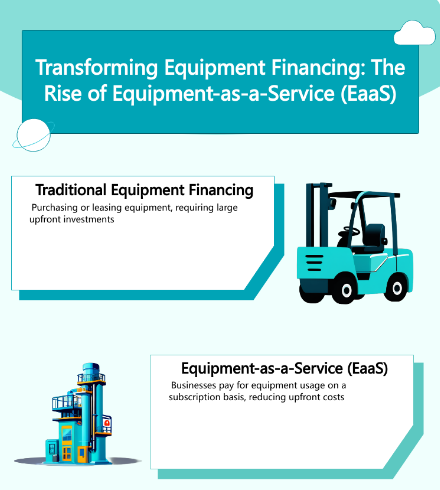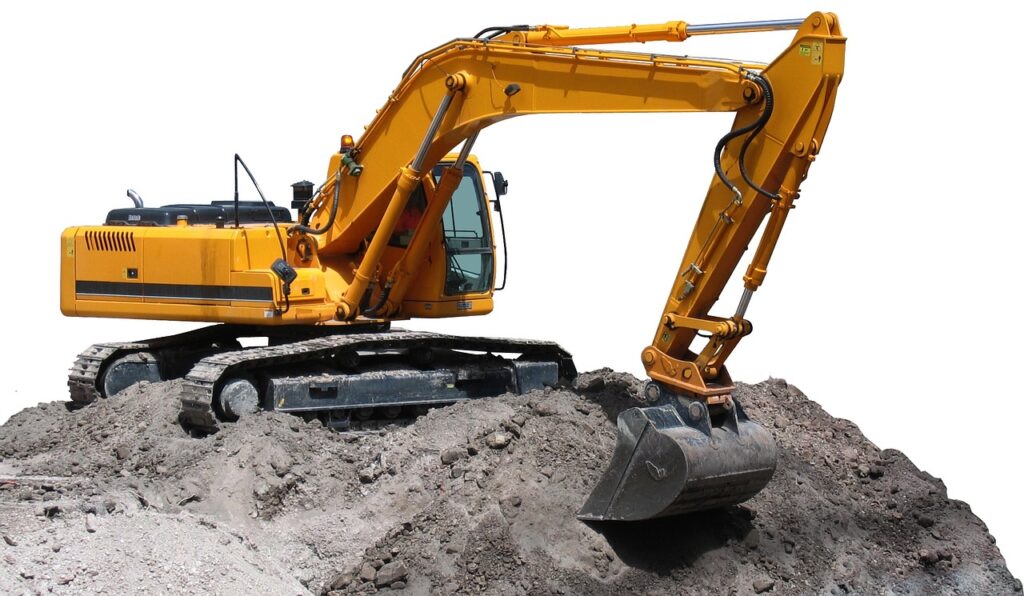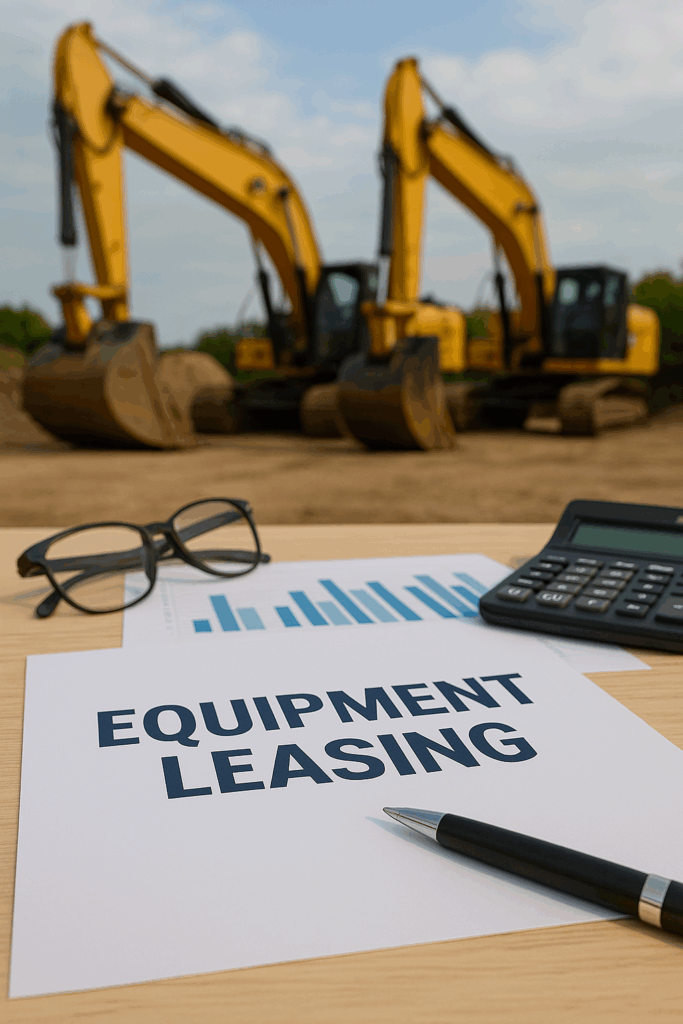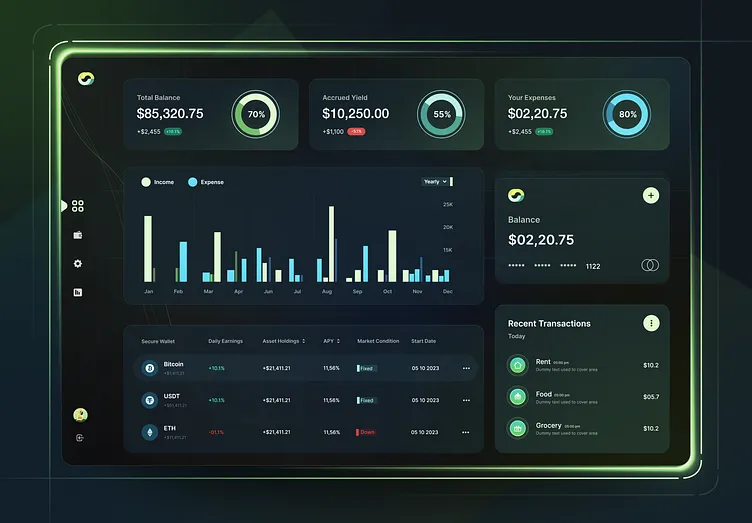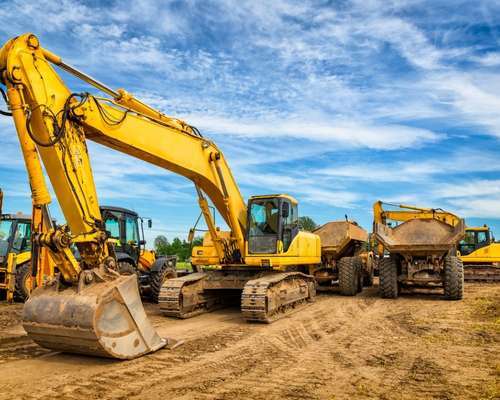In the evolving landscape of equipment financing, Equipment-as-a-Service (EaaS) has emerged as a transformative model, offering businesses flexible, subscription-based access to essential equipment. This paradigm shift aligns with the increasing demand for operational efficiency and technological advancement.
Understanding Equipment-as-a-Service (EaaS)
In the evolving landscape of business operations, the Equipment-as-a-Service (EaaS) model has emerged as a transformative approach to equipment procurement and management. Unlike traditional methods that require substantial upfront capital investments, EaaS allows companies to access necessary equipment through subscription-based or usage-dependent payment structures. This paradigm shift enables businesses to utilize state-of-the-art equipment without the financial burdens and responsibilities associated with ownership.
Key Features of the EaaS Model
Subscription-Based Access: Companies pay a recurring fee to use equipment, aligning costs with actual usage and operational needs.
Service Provider Ownership: The equipment remains under the ownership of the service provider, who is responsible for its maintenance and upgrades.
Comprehensive Service Packages: Providers offer inclusive packages that cover maintenance, support, and regular upgrades, ensuring optimal performance and access to the latest technology.
Advantages of Adopting EaaS
Financial Flexibility: By converting capital expenditures (CapEx) into operational expenditures (OpEx), businesses can preserve capital for other strategic investments.
Access to Cutting-Edge Technology: EaaS ensures that companies have access to the latest equipment without the risk of obsolescence, as providers handle timely upgrades.
Operational Efficiency: With maintenance and support managed by the provider, companies can focus on their core operations, reducing downtime and enhancing productivity.
Industry Applications of EaaS
Manufacturing: Enables manufacturers to scale operations and adopt new technologies swiftly without significant capital outlay.
Healthcare: Allows healthcare facilities to access advanced medical equipment, improving patient care while managing costs effectively.
Construction: Provides construction firms with flexible access to machinery and tools, aligning equipment availability with project demands.
Implementing EaaS: Considerations for Businesses
Assess Operational Needs: Evaluate the specific equipment requirements and determine if EaaS aligns with operational goals and financial strategies.
Select Reputable Providers: Partner with service providers who have a proven track record and can offer reliable support and maintenance services.
Understand Contractual Terms: Carefully review service agreements to ensure they provide the desired flexibility and align with business objectives.
By embracing the EaaS model, businesses can achieve greater agility, reduce financial strain, and maintain competitiveness in rapidly changing markets. This approach not only optimizes resource utilization but also fosters innovation by providing access to the latest technological advancements without the constraints of traditional ownership.
The Evolution of Equipment Financing Models
Traditional equipment financing has typically required substantial capital expenditures and long-term commitments, often leading to financial strain and reduced operational flexibility for businesses. In contrast, the Equipment-as-a-Service (EaaS) model offers a more agile alternative, allowing companies to scale their equipment usage based on current needs. This flexibility is particularly advantageous in industries with rapidly evolving technological landscapes, as it mitigates the risk of equipment obsolescence.
EaaS enables businesses to convert large capital expenditures into manageable operational expenses, preserving capital for other strategic investments. By adopting a subscription-based or usage-dependent payment structure, companies can access cutting-edge equipment without the burdens associated with ownership. Service providers retain ownership of the equipment and offer comprehensive packages that include maintenance, upgrades, and support services, ensuring that businesses have access to the latest technology without the associated risks.
This model fosters greater operational agility, allowing companies to respond swiftly to market changes and technological advancements. By aligning equipment usage with actual demand, businesses can optimize their operations and maintain a competitive edge in their respective industries.
Benefits of Equipment-as-a-Service (EaaS) for Businesses
Cost Efficiency
Transitioning from capital expenditures (CapEx) to operational expenditures (OpEx) through EaaS alleviates the financial burden of large upfront investments. This shift enables businesses to allocate resources more strategically, preserving capital for other critical areas of operation.
Scalability and Flexibility
EaaS models provide the agility to adjust equipment usage in response to fluctuating market conditions and operational demands. This flexibility is essential in today’s dynamic business environment, allowing companies to scale operations seamlessly.
Access to Advanced Technology
By adopting EaaS, businesses gain access to state-of-the-art equipment without the risk of obsolescence. Service providers ensure that equipment is regularly upgraded, keeping companies at the forefront of technological advancements.
Enhanced Maintenance and Support
EaaS providers typically handle maintenance, repairs, and technical support, reducing downtime and operational disruptions. This arrangement allows businesses to focus on their core competencies while leaving equipment-related tasks to the experts.
By leveraging the EaaS model, businesses can optimize operations, reduce costs, and enhance efficiency, positioning themselves for sustainable success in a competitive marketplace.
EaaS in Practice: Industry Applications
The Equipment-as-a-Service (EaaS) model is revolutionizing various industries by providing flexible, cost-effective access to advanced equipment. This approach enables companies to adapt swiftly to technological advancements and market demands without the financial burdens of ownership.
Manufacturing
Manufacturers are increasingly adopting EaaS to access state-of-the-art machinery without significant capital expenditures. This model allows them to respond promptly to evolving market demands and technological innovations, enhancing operational efficiency and competitiveness. By leveraging EaaS, manufacturers can scale production capacity as needed, optimize resource allocation, and focus on core competencies.
Healthcare
In the healthcare sector, EaaS facilitates the acquisition of cutting-edge medical equipment, ensuring high-quality patient care while effectively managing costs. Healthcare providers can access the latest diagnostic and therapeutic technologies without the financial strain of outright purchases. This model also ensures compliance with stringent regulatory standards and supports the integration of advanced technologies into patient care.
Construction
The construction industry benefits from EaaS by obtaining essential equipment for projects without long-term financial commitments. This flexibility allows construction firms to adapt to varying project requirements and market conditions, optimizing equipment utilization and project outcomes. EaaS also facilitates access to specialized machinery, enhancing project efficiency and enabling firms to undertake diverse projects.
Additional Industry Applications
Agriculture: Farmers utilize EaaS to access modern machinery, improving productivity and sustainability without substantial capital investments.
Logistics and Transportation: Companies leverage EaaS to maintain up-to-date fleets, enhancing operational efficiency and reducing maintenance costs.
Energy Sector: Energy companies adopt EaaS for equipment like turbines and generators, aligning with evolving energy demands and technological advancements.
Implementing Equipment-as-a-Service (EaaS): Strategic Considerations for CFOs and CEOs
Adopting the Equipment-as-a-Service (EaaS) model can significantly enhance operational flexibility and financial efficiency. However, its successful implementation requires careful strategic planning and evaluation. Key considerations for Chief Financial Officers (CFOs) and Chief Executive Officers (CEOs) include:
Assessing Organizational Needs
Comprehensive Evaluation: Conduct a thorough analysis of your organization’s equipment requirements, operational workflows, and long-term strategic objectives. Determine how EaaS can align with and support these goals.
Financial Impact Analysis: Assess the potential financial implications of transitioning from capital expenditures (CapEx) to operational expenditures (OpEx). This includes understanding the effects on cash flow, balance sheets, and key financial ratios.
Risk Management: Identify and evaluate risks associated with equipment availability, performance, and potential disruptions. Develop mitigation strategies to ensure continuity of operations.
Selecting the Right Service Provider
Due Diligence: Investigate potential EaaS providers’ reputations, financial stability, and track records in delivering reliable and high-quality services.
Service Level Agreements (SLAs): Ensure that SLAs clearly define performance metrics, maintenance responsibilities, response times, and penalties for non-compliance.
Technological Compatibility: Verify that the provider’s equipment and technology integrate seamlessly with your existing systems and processes.
Scalability and Flexibility: Choose a provider capable of scaling services to match your organization’s growth and adapting to evolving operational needs.
Understanding Contract Terms
Financial Terms: Scrutinize pricing structures, payment schedules, and any additional costs. Ensure that terms are transparent and align with your financial planning.
Duration and Renewal Clauses: Review contract length, renewal conditions, and termination clauses. Ensure they provide the flexibility to adapt to future changes in strategy or market conditions.
Ownership and Data Rights: Clarify ownership of equipment and any data generated during its use. Ensure your organization retains access to critical operational data.
Compliance and Regulatory Considerations: Ensure that the contract complies with relevant industry regulations and standards and that the provider adheres to necessary compliance requirements.
Change Management and Stakeholder Engagement
Internal Alignment: Engage cross-functional teams to ensure alignment and support for the EaaS initiative. Address concerns and highlight benefits to gain buy-in.
Training and Support: Implement training programs to familiarize employees with new equipment and processes. Ensure ongoing support is available to facilitate a smooth transition.
Performance Monitoring: Establish key performance indicators (KPIs) to monitor the effectiveness of the EaaS model. Regularly review these metrics to assess performance and identify areas for improvement.
By meticulously addressing these considerations, CFOs and CEOs can effectively implement the EaaS model, driving operational efficiency and fostering sustainable growth.
The Future of Equipment Financing: Trends and Projections
The Equipment-as-a-Service (EaaS) model is reshaping equipment financing across various industries, driven by the demand for flexibility, technological advancement, and cost efficiency.
Market Growth and Adoption
Exponential Market Expansion: The global EaaS market was valued at approximately USD 1.5 billion in 2023 and is projected to reach USD 27.8 billion by 2030, growing at a compound annual growth rate (CAGR) of 53.0% from 2024 to 2030.
Cross-Industry Adoption: Industries such as manufacturing, construction, healthcare, and mining are increasingly adopting EaaS models to enhance operational efficiency and reduce capital expenditures.
Technological Advancements Driving EaaS
Integration of IoT and Predictive Maintenance: The incorporation of Internet of Things (IoT) technologies enables real-time monitoring and predictive maintenance, enhancing equipment reliability and performance.
Data-Driven Decision-Making: Advanced analytics provide insights into equipment usage patterns, allowing for optimization of operations and informed decision-making.
Regional Trends
North America Leading Adoption: North America is expected to hold a significant share of the EaaS market, with projected revenues reaching USD 9.4 billion by 2030, driven by technological advancements and a strong industrial base.
Asia-Pacific Emerging as a Key Player: The Asia-Pacific region is anticipated to exhibit the fastest growth, with a CAGR of 56.8% over the forecast period, due to rapid industrialization and increasing adoption of advanced technologies.
Future Projections
Sustainable and Energy-Efficient Solutions: There is a growing emphasis on sustainability, leading to the adoption of energy-efficient equipment and practices within the EaaS framework.
Expansion into New Sectors: Beyond traditional industries, sectors such as agriculture, logistics, and information technology are expected to increasingly adopt EaaS models to leverage operational flexibility and cost savings.
In conclusion, the EaaS market is poised for substantial growth, reshaping equipment financing and utilization across industries. Organizations that embrace this model can achieve enhanced operational efficiency, cost-effectiveness, and adaptability in a rapidly evolving technological landscape.
